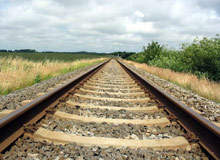
Railway sleepers, or railroad ties as they are known in the US, are a somewhat unglamorous component of the rail industry. But these blocks, which are laid horizontally underneath tracks to hold rail lines in place at the correct gauge, form the backbone of rail travel. Millions of these vital blocks are manufactured and distributed every year to satisfy demand for network expansions and line upgrades.
Apart from some experiments with stone block sleepers at the earliest stages of rail transport’s development, timber has been the historically dominant material used for railway sleepers. Through the 20th century, new materials have emerged to respond to the need to accommodate higher axle loads and faster speeds. Here, we weigh up the advantages and disadvantages of the materials on offer.
Wooden sleepers
Given that wood has been used for the better part of two centuries to make railway sleepers, it is surprising that wooden sleepers still comprise the majority of the railway sleeper market. This is particularly the case in the US, where wood has a 93% share of the market – 16 million wooden ties are laid every year.
It’s no accident that timber’s market ascendancy has never waned. The natural properties of wood (usually hardwood such as oak, but cheaper softwood has been used on lighter, less busy lines) are suited to providing a resilient track with excellent dynamic attenuation of impact loading as well as noise and vibration reduction.
Wooden sleepers are also comparatively cheap, as well as light and easy to transport, install and maintain. The average timber sleeper weighs around 160lb-250lb, whereas an equivalent sleeper made of concrete could weigh anything up to 800lb. This means that wooden sleepers are quicker and easier to install initially and require little to no specialist equipment or vehicles for maintenance, which means cost-savings for rail operators.
How well do you really know your competitors?
Access the most comprehensive Company Profiles on the market, powered by GlobalData. Save hours of research. Gain competitive edge.

Thank you!
Your download email will arrive shortly
Not ready to buy yet? Download a free sample
We are confident about the unique quality of our Company Profiles. However, we want you to make the most beneficial decision for your business, so we offer a free sample that you can download by submitting the below form
By GlobalDataProponents of timber for railway sleepers have also pointed to the strong second market for disused wooden railway sleepers.
There is a booming business for reclaiming used railway sleepers as a hardy material for gardening and landscaping or to use as biomass fuel for cogeneration power plants. However, the majority of timber sleepers are soaked in coal tar creosote in order to protect them from environmental wear and insect infestation. Creosote extends the life of wooden sleepers (untreated timber sleepers usually have to be replaced every seven to 12 years) but is a toxic hazard which creates an added cost for disposal and has damaged the environmental credibility of the industry’s traditional sleeper material.
Wood is also far more susceptible to wear and tear than more modern sleeper materials. Operators are increasingly replacing timber with concrete or composites in areas where sun and damp can warp or rot timber.
The case for concrete sleepers
Although concrete sleepers have captured only a small fraction of the market in the US, in Europe and Japan, where rail transport is arguably a higher priority, concrete sleepers have been gaining ground since the end of World War II. In Australia, concrete is used for most railway sleepers, and in the UK, rail operator Network Rail replaces 200,000 wooden sleepers with concrete ones every year.
Concrete sleepers are generally made from cast concrete slabs reinforced internally by steel wire. Early prototypes made with conventional reinforced concrete were often found too brittle to withstand high levels of dynamic load. Modern concrete sleepers are primarily manufactured using pre-stressed concrete – a technique where internal tension is introduced to the sleeper (usually to the high-tensile steel wire skeleton) before it is cast to counteract the external pressure the blocks undergo during service.
Concrete manufacturers such as Abetong Teknik, INFRASET and Stanton Bonna have made a strong case for the performance of concrete in the railway sleeper market. The material requires less maintenance and has a longer service life than timber sleepers, as it is not prone to environmental degradation, warping or insect infestation and its non-combustible nature means it lessens the potential for track fires.
Pre-stressed concrete sleepers can also boast a generally superior load capacity and a smoother ride as a result of their greater weight and vertical / lateral stability. For the most modern high-speed lines, concrete (or composite plastic) becomes a necessity to bear higher speeds
But critics have been quick to point out that the weight and bulk of concrete sleepers is a significant disadvantage when it comes to the cost – both in time and money – of initial installation and later repairs.
While wooden ties can be put in place fairly quickly and with little specialist equipment, concrete sleepers must be installed using heavy machinery.
As pre-stressed concrete requires a skilled workforce and specialist equipment to manufacture, this high-quality material is certainly not a cheap option, although concrete manufacturers argue that the durability of the material means higher value over the lifespan of concrete sleepers.
Limited adoption of steel sleepers
Steel railway sleepers are often seen as a middle ground between wood and concrete. Sturdier than timber and less expensive than pre-stressed concrete, it seemed logical that steel could prove a boon to companies looking to undertake an economical track upgrade. Indeed, in some areas steel ties are still performing adequately after 50 years of service. A lesser reliance on ballast (approximately 60% less than required for concrete; 45% less than wood) also seems to tip the scale in steel’s favour, especially in areas where timber is scarce.
But a number of unique problems have limited the adoption of steel for sleeper applications, especially in the US with its abundance of natural timber resources. Steel sleepers are susceptible to corrosion and rail operators have reported in the past that steel ties have been removed from tracks after rail seats became quickly fatigued, especially on lines with many turns.
Capital Metro, the transit authority for Austin, Texas, provides a good example of another common problem specific to steel ties – the lack of insulation. Neoprene composite insulation keeps steel ties separate from electrified rails, but any error can wreak havoc on a rail network. A report in the Austin American-Statesman in March 2010 noted that as a result of conductivity problems and signal failures, Capital Metro has been forced to replace long sections of steel sleepers with timber at an additional cost of $90,000. “I wish I’d never done it,” Capital Metro railroad manager Bill Le Jeune told the newspaper.
Plastic composites: the material of the future?
The most modern material being used for railway sleepers, plastic composite, represents manufacturers’ latest attempt to find a material that fulfils the necessary criteria without any significant drawbacks. Composite sleepers are made from various mixtures of raw materials (plastic, rubber from used tyres, waste fibreglass) to create a synthetic material with the pliability and accessibility of wood, coupled with the durability of concrete.
Japan has been a leader in composite manufacturing. Japanese manufacturer Sekisui Chemical provided fibre-reinforced foamed urethane (FFU) sleepers for the Shinkansen high-speed train. 90,000 FFU sleepers are laid every year in the country, with nearly 1.5 million in current service.
Sekisui’s composite sleepers made their European debut in 2004 when they were installed on the tracks of the Zollamt Bridge in Vienna, Austria. The material was chosen for the bridge because it matched the performance of wood while remaining unaffected by temperature changes and the constant moisture hanging in the air.
The advantages of composites are clear – the material can be manipulated and sawed just like wood, without any of the inbuilt disadvantages of its all-natural counterpart. It has the durability of concrete (composites have a service lifespan of 50 years or more), without concrete’s weight and ponderous installation process. Unlike concrete sleepers, for which a track must be completely overhauled, composite sleepers can be installed piecemeal alongside older timber models.
Composite sleepers have the additional advantage of being made from mostly recycled material, and are fully recyclable (they can be recycled into new sleepers). A 2006 report by the waste and resources action programme (WRAP) notes that a mile of wooden sleepers requires 810 mature oak trees, while an equivalent length of composite sleepers uses two million plastic bottles, 8.9 million plastic bags and 10,800 post-consumer tyres that could otherwise end up in landfill.
It’s clear that composite material (or a derivation of the technology) holds the key to creating a widely adopted, environmentally friendly and operationally efficient substance for the railway sleeper industry. Cost concerns have generally limited its use to lines where timber and concrete are unsuitable, but as the manufacturing process becomes more refined and affordable for the sleeper market it seems there will be little standing in the way of composites catching up and overtaking timber as the sleeper material of choice.




